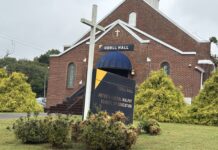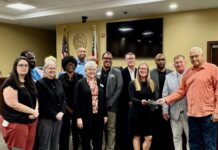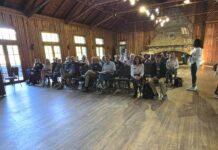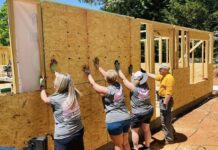
The American flag in front of the school waved from half-staff early morning Monday before students returned for an open house at Apalachee High School.
The sun rose, warming the air and lighting the flowers and tributes that decorated the base of the flagpole.
As teachers and school staff prepared for the day, a voice resonated across an empty school parking lot with announcements and, just before 8:30 a.m., the Pledge of Allegiance.
“Please join me in making today a great day,” the voice said afterward.
Everyone within the sound of that voice knew that all the tomorrows to come could be tough as students who lived through the recent school shooting return to part-time classes.
The Director of the National Center for School Crisis and Bereavement at Children’s Hospital Los Angeles, David Schonfeld, helped the school prepare mental health resources and support for students and staff coping with tremendous grief.
Barrow County schools invited Schonfeld to Apalachee High right after the Sept. 4 shooting in which a 14-year-old shot and killed two math teachers and two 14-year-old peers, wounding another teacher and eight students.
He stayed a week, training mental health crisis teams to support survivors during their first week back.
“What we try and do is minimize the amount of what we would call kind of traumatic triggers,” Schonfeld said. “So, it may be that they go back to the school, but they don’t go back to the same location in the school.”
MORE: GEMA opens center in Barrow County to help with community needs after high school shooting
Monday’s four-hour open house allowed students and their parents to walk through the building and reconnect with teachers.
J Hall, where the shooting took place, is closed and will remain so for the rest of the year.
Any student who has a class there will take a bus 1.5 miles away to another school-owned building instead.
The hope is that the rest of the school building can be a safe space.
“It isn’t just that they’re returning back to the site where a tragedy occurred,” Schonfeld said. “They’re also returning to their school where they have other positive associations, hopefully.”

Schonfeld helps mental health crisis teams after school shootings such as the one in 2018 at Marjory Stoneman Douglas High School in Parkland, Fla., among others.
Schonfeld said he recently visited Georgia to conduct similar training for the state’s Project AWARE: Advancing Wellness and Resilience in Education.
“A lot of what we do is not just around violence,” he said. “It’s also around natural disasters and bereavement of all causes. And those things are not going to end, either, obviously.”
Bibb, Houston, and Hall counties received five-year federal grants in September 2020 to support more community and school-based mental health services for children. Before that, Project AWARE grants went to Griffin-Spalding and Muscogee and Newton County schools for things like screening, outreach, and behavioral health awareness campaigns.
Sonya Turner, the mother of two children who were in Apalachee High School the day of the shooting, said the priority for now is mental health over schoolwork.
While some kids are eager to get back to their friends, some are so grief-stricken they can’t eat, Turner said.
“There’s not a one-size-fits-all,” she said. “They are going to be very patient with everybody. And they’re trying to do things and exposures in small doses to get a, I guess, like a threshold or a temperature of where people are.”
School officials are providing more counselors and therapy dogs, and there will be an increased police presence.
RELATED: How Roswell High School addresses student mental health needs amid dual deadly epidemics
Ashleigh Dennis Silas is the vice president of Mental Health and Wellness at CHRIS 180, a school-based mental health care provider in the Atlanta area.
Silas said there are skills students need to learn to handle grief, which may never go away.
“So, we’re going to teach how to affect regulation, and we’re going to teach how to identify feelings, how to manage moods, and how to express those things that the kids are experiencing,” she said. “How to cope with the different things that they’re dealing with, and then also going to extend that skill set to the family.”
Apalachee High School students are still experiencing anxiety, discomfort and dysregulation post-COVID-19 pandemic, when many of these students were in middle school, Silas said.
“And so “[the school shooting is] another major incident where kids feel unsafe, where they’re outside of a normal routine,” Silas said. “Things that we don’t expect to happen are occurring. So, just a great deal of concern about what that is going to look like for the long term.”
Schonfeld began teaching these skills in New York City schools after 9/11. Later, he helped respond to the Parkland shooting in Florida.
He said he didn’t think he’d still be doing the work today or that it would become his career.
“I finally concluded I was wrong and that it really was something that I don’t anticipate will end sometime during my natural lifespan,” he said.
Schonfeld said he still has hope one day that might change.
Students at Apalachee High School will return full time in mid-October.
School shootings have risen in frequency in the past 25 years and are now at their highest-recorded and most deadly levels, with 27 people, including the shooters, who have died in Georgia school shootings, the K-12 School Shooting Database reports.
Students nationwide react to violence whether they experience trauma firsthand or not, according to studies, which also say school-based interventions and effective approaches should be used to support students’ mental health and academic and behavioral needs.
The American School Counselor Association’s recommended ratio is one counselor for every 250 students. Georgia currently allows for one counselor for every 450 students, which is worse than the national average.
This article comes to Now Habersham in partnership with GPB News






